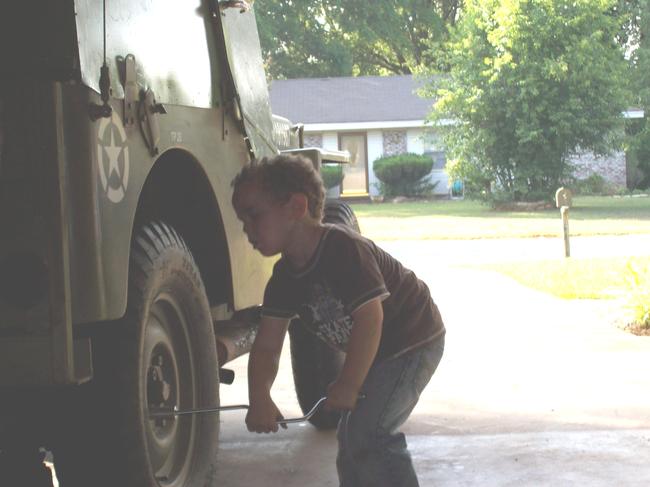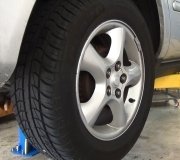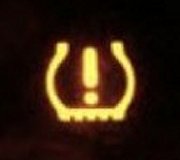Please excuse me for butting in, but I'd like to add a few details. If you mean the tire can be pushed and pulled in and out on the top and bottom, that does sound like the wheel bearing assembly, but they almost always make a loud buzzing noise long before they develop that much play. A half inch is a real lot of play. GM has a lot of trouble with anti-lock wheel speed sensors which are built into the bearing assembly. They develop pretty wimpy signals to start with, and just a tiny amount of play will let the sensor move away from the tone ring and make the wheel speed signal so weak the computer can't read it. That will cause the computer to set a diagnostic fault code for that wheel, turn the system off, and turn the yellow warning light on to tell you. If you have anti-lock brakes and the light isn't on and the system is working, there is something else wrong besides the wheel bearing. The upper and lower ball joints would be the main suspects.
The first thing I would do is have the steering and suspension systems inspected at a different tire and alignment shop, but do not tell them about the bearing. Doing so could limit the scope of their inspection since some mechanics just verify what they're told someone else found, and assume if anything else was wrong, you would have been told about that too and mentioned it to them. Let them find everything on their own. If the person writing up the repair order is doing his job, he will ask why you want the inspection and if you're having any symptoms or problems. Since they'll see the new tires, you can say the old ones had bad wear patterns, the steering wanders at highway speeds, or something like that.
If the second mechanic verifies the wheel bearing needs to be replaced, it can be a do-it-yourself repair if you have the right tools. I just changed one today on a Trail Blazer, (its fourth new bearing). You'll need to remove the brake caliper and mounting knuckle, but the caliper can remain on the knuckle. That involves two 18mm bolts. Three 15mm bolts are removed from the backside of the knuckle, then you may need to use a chisel and hammer to get the bearing out of the hole it sits in. The one I did today fell out because it didn't have enough time to get rusted in. You'll need a 35mm deep socket to remove the axle nut, then the bearing will slide out.
Do not ever let the caliper hang by the rubber hose. That can tear it inside. Use some type of wire or rubber strap to hold it up.
One major word of warning about that axle nut. Some of them are a one-time-use nut since the threads stretch the first time. Most of the time, if you buy a name-brand bearing, it will come with a new nut if it is required, and it may come with a new one even if it isn't required. Use the new nut if you get one. The biggest concern is that nut absolutely must be torqued to the specified value before any vehicle weight is placed on the bearing. This is true of any front wheel bearing on any brand of vehicle. Some people lower the vehicle after the wheel is installed so the tire will prevent the wheel and axle from turning so they can tighten the axle nut. Doing that will instantly damage the new bearing. About nine out of ten times the bearing will become noisy and make that buzzing noise, but once in a while that doesn't show up for a few weeks. All you have to do is stick a screwdriver into one of the vent holes in the rotor to keep the axle from turning so you can tighten that nut.
The torque value is critical too, and very high. You must use a click-type torque wrench. The most common value is 180 foot pounds. Almost all Chrysler products call for that, and most Fords do. There are some GM models that call for 240 foot pounds. You can lower the vehicle onto the tires once that nut is tightened to the specified value.
If you don't have a click-type torque wrench, the auto parts store you get the bearing from may have one you can borrow. A lot of auto parts stores are renting or borrowing tools now. They'll show you how to adjust it and use it. Be sure to adjust it back down when you're done. That relieves the tension on the internal spring which helps to keep it in calibration.
Before you put the rotor back on, look at the center of the backside that sits against the hub. Scrape off any rust that formed by the access holes in the hub of the old assembly, and any rust along the outer edge of that contact area. If there's any rust that gets wedged between the rotor and hub when you tighten the lug nuts, it will make the rotor and wheel wobble and shake the steering wheel.
Use that torque wrench on the lug nuts too. Over and under-tightening those nuts can lead to wheels falling off or tearing the threads on the nuts and studs. Stud and nut damage from over-tightening will not show up until the next time you try to remove the nuts. A lot of mechanics are falsely accused of causing that damage when they try to remove the nuts, when in reality, it was the last person who worked on the vehicle who is responsible, and often that's the owner. In repair shops with conscientious owners and managers, failure to use a torque wrench will usually get you one pretty stern lecture, but that's it. The next time you'll be invited to look for a job somewhere else. It's really that big a deal. Owners don't have time to sit in a courtroom, especially if the problem could have easily been prevented by following simple procedures.
If the new bearing doesn't come with an instruction sheet with the torque specs listed, the auto parts store may have that information. They usually supply shops with wall charts that list lug nut specs for almost all car brands. 95 foot pounds is typical for most smaller cars. Trucks usually call for a little more, and the values are lower for cast aluminum wheels. Higher values will deform the contact area of the wheel. That friction surface is what holds the lug nuts from coming loose.
You can put a light film of grease on the threads of the studs, but absolutely no anti-seize compound. Anti-seize will get you fired in a hurry because it will let the nuts work loose. Too much grease is a problem too. When air tools are used to run the nuts on, the grease builds up ahead of them, then centrifugal force will fling the grease onto the friction surface of the nuts and wheel. Where the nuts contact the wheel must be perfectly dry and those surfaces must match perfectly.
A lot of studs are anodized with an electrically-plated coating. Those must not have any grease as that will dissolve the plating. That plating actually acts like a lubricant. Those studs will have a bluish, yellowish, or silver tint. Only use grease very sparingly if the studs are black.
There are torque specs too for the three bearing bolts and the two that hold the caliper's mount to the knuckle, but those bolts are less critical. You won't over-tighten them with hand tools, but you should pay attention to how tight they are when you remove them so you can tighten them a similar amount. Most mechanics go by common sense on those bolts, but common sense isn't always so common for do-it-yourselfers.
Sunday, June 29th, 2014 AT 10:44 PM




